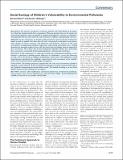| dc.contributor.author | Weiss, Bernard | |
| dc.contributor.author | Bellinger, David C. | |
| dc.date.accessioned | 2012-01-07T05:05:26Z | |
| dc.date.issued | 2006 | |
| dc.identifier.citation | Weiss, Bernard and David C. Bellinger. 2006. Social ecology of children's vulnerability to environmental pollutants. Environmental Health Perspectives 114(10): 1479-1485. | en_US |
| dc.identifier.issn | 0091-6765 | en_US |
| dc.identifier.uri | http://nrs.harvard.edu/urn-3:HUL.InstRepos:7126481 | |
| dc.description.abstract | Background: The outcomes of exposure to neurotoxic chemicals early in life depend on the properties of both the chemical and the host’s environment. When our questions focus on the toxicant, the environmental properties tend to be regarded as marginal and designated as covariates or confounders. Such approaches blur the reality of how the early environment establishes enduring biologic substrates. Objectives: In this commentary, we describe another perspective, based on decades of biopsychological research on animals, that shows how the early, even prenatal, environment creates permanent changes in brain structure and chemistry and behavior. Aspects of the early environment—encompassing enrichment, deprivation, and maternal and neonatal stress—all help determine the functional responses later in life that derive from the biologic substrate imparted by that environment. Their effects then become biologically embedded. Human data, particularly those connected to economically disadvantaged populations, yield equivalent conclusions. Discussion: In this commentary, we argue that treating such environmental conditions as confounders is equivalent to defining genetic differences as confounders, a tactic that laboratory research, such as that based on transgenic manipulations, clearly rejects. The implications extend from laboratory experiments that, implicitly, assume that the early environment can be standardized to risk assessments based on epidemiologic investigations. Conclusions: The biologic properties implanted by the early social environment should be regarded as crucial elements of the translation from laboratory research to human health and, in fact, should be incorporated into human health research. The methods for doing so are not clearly defined and present many challenges to investigators. | en_US |
| dc.language.iso | en_US | en_US |
| dc.publisher | National Institute of Environmental Health Sciences | en_US |
| dc.relation.isversionof | doi://10.1289/ehp.9101 | en_US |
| dc.relation.hasversion | http://www.ncbi.nlm.nih.gov/pmc/articles/PMC1626436/pdf/ | en_US |
| dash.license | LAA | |
| dc.subject | covariates | en_US |
| dc.subject | effect modification | en_US |
| dc.subject | environment deprivation | en_US |
| dc.subject | environmental enrichment | en_US |
| dc.subject | risk assessment | en_US |
| dc.title | Social Ecology of Children’s Vulnerability to Environmental Pollutants | en_US |
| dc.type | Journal Article | en_US |
| dc.description.version | Version of Record | en_US |
| dc.relation.journal | Environmental Health Perspectives | en_US |
| dash.depositing.author | Bellinger, David C. | |
| dc.date.available | 2012-01-07T05:05:26Z | |
| dash.affiliation.other | HMS^Neurology-Children's Hospital | en_US |
| dash.affiliation.other | SPH^Exposure Epidemiology and Risk Program | en_US |
| dc.identifier.doi | 10.1289/ehp.9101 | * |
| dash.contributor.affiliated | Bellinger, David | |


